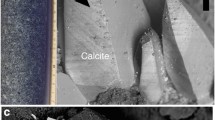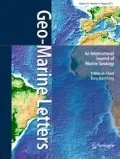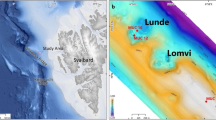Abstract
Stable carbon isotope values of authigenic carbonate rocks in the Miocene terrigenous sediments of Piedmont indicate a methane-related origin. Some of these methane-derived carbonates (Lucina limestone) are characterized by the presence of abundant lucinid remains. Carbonate dissolution/precipitation and development of lucinid communities were related to bacterial methane oxidation, both aerobic and anaerobic. Anaerobic oxidation led to carbonate precipitation and production of sulfide, which sustained lucinid communities through chemosynthetic symbiotic bacteria. Aerobic oxidation of methane likely resulted in dissolution of carbonate skeletal grains. Several phases of carbonate precipitation, characterized by slightly different isotopic compositions, are recognizable in the limestones.
Similar content being viewed by others

References
Beauchamp B and Savard M (1992) Cretaceous chemosynthetic carbonate mounds in the Canadian Arctic. Palaios 7:434–450
Bonci C, Clari P, Ferrero E, Ghibaudo G, Pirini C, Ricci B, Valleri G, and Violanti D (1990) The Diatomites of Marmorito (western Monferrato, northern Italy). Memorie di Scienze Geologiche 42:189–225
Brooks JM, Kennicutt MC II, Fisher CR, Macko SA, Cole K, Childress JJ, Bidigare RR, and Vetter RD (1987) Deep-sea hydrocarbon seep communities: Evidence for energy and nutritional carbon sources. Science 238:1138–1142
Callender WR and Powell EN (1992) Taphonomic signature of petroleum seep assemblages on the Louisiana upper continental slope: Recognition of autochthonous shell beds in the fossil record. Palaios 7:388–408
Campbell KA (1992) Recognition of ancient cold seep biota from the northeast Pacific convergent margin. Palaios 7:422–433
Cary SC, Vetter RD, and Felbeck H (1989) Habitat characterization and nutritional strategies of the endosymbiont-bearing bivalve Lucinoma aequizonata. Marine Ecology Progress Series 55:31–45
Childress JJ, Fisher CR, Brooks JM, Kennicutt MC II, Bidigare R, and Anderson AE (1986) A methanotrophic marine molluscan (Bivalvia, Mytilidae) symbiosis: Mussel fueled by gas. Science 233:1306–1308
Clari P, Gagliardi C, Governa ME, Ricci B, and Zuppi GM (1988) I Calcari di Marmorito: Una testimonianza di processi diagenetici in presenza di metano. Bollettino Museo Regionale Scienze Naturali Torino, 6:197–216
Gaillard C, Bourseau JP, Boudeulle M, Pailleret P, Rio M, and Roux M (1985) Les pseudo-biohermes de Beauvoisin (Drome): Un site hydrotermal sur la marge téthysienne à l'Oxfordien? Bulletin de la Société Géologique de France 1:69–78
Goedert JL and Squires RL (1990) Eocene deep-sea communities in localized limestones formed by subduction-related methane seeps, southwestern Washington. Geology 18:1182–1185
Hovland M, Talbot M, Qvale H, Olaussen S, and Aasberg L (1987) Methane-related carbonate cements in pockmarks of the North Sea. Journal of Sedimentary Petrology 57:881–892
Jørgensen NO (1989) Holocene methane-derived, dolomite-cemented sandstone pillars from the Kattegat, Denmark. Marine Geology 88:71–81
Kulm LD, Suess E, Moore JC, Carson B, Lewis BT, Ritger SD, Kadko DC, Thornburg TM, Embley RW, Rugh WD, Massoth GJ, Langseth MG, Cochrane GR, and Scamman RL (1986) Oregon subduction zone: Venting, fauna and carbonates. Science 231:561–566
Matsumoto R (1990) Vuggy carbonate crust formed by hydrocarbon seepage on the continental shelf of Baffin Island, northeast Canada. Geochemical Journal 24:143–158
McCrea JM (1950) On the isotope chemistry of carbonates and a paleotemperature scale. Journal of Chemical Physics 18:849–857
Moroni AM (1966) Malacofauna del “calcare a Lucine” di S. Sofia—Forlì. Paleontographia Italica 60:69–87
Paull CK, Martens CS, Chanton JP, Neumann AC, Coston JA, Jull AJT, and Toolin LT (1989) Old carbon in living organisms and young CaCO3 cements from abyssal brine seeps. Nature 342 166–168
Paull CK, Chanton JP, Neumann AC, Coston JA, Martens CS, and Showers W (1992) Indicators of methane-derived carbonates and chemosynthetic organic carbon deposits: Examples from the Florida Escarpment. Palaios 7:361–375
Reid RGB and Brand DG (1986) Sulfide-oxidizing syrnbiosis in Lucinaceans: Implications for bivalve evolution. The Veliger 29:3–24
Ricci Lucchi F and Veggiani A (1967) I calcari aLucina della Formazione Marnoso-arenacea romagnola. Nota preliminare. Giornale di Geologia 34:159–172
Ritger S, Carson B, and Suess E (1987) Methane-derived authigenic carbonates formed by subduction-induced pore-water expulsion along the Oregon/Washington margin. Bullettin of the Geological Society of America 98:147–156
Sacco F (1901) Sul valore stratigrafico delle grandi Lucine dell'Appennino. Bollettino della Società Geologica Italiana 20:563–574
Turner RD (1985) Notes on mollusks of deep-sea vents and reducing sediments. American Malacological Bullettin Special Edition 1:23–34
Author information
Authors and Affiliations
Rights and permissions
About this article
Cite this article
Clari, P., Fornara, L., Ricci, B. et al. Methane-derived carbonates and chemosymbiotic communities of Piedmont (Miocene, northern Italy): An update. Geo-Marine Letters 14, 201–209 (1994). https://doi.org/10.1007/BF01203732
Received:
Revised:
Issue Date:
DOI: https://doi.org/10.1007/BF01203732



